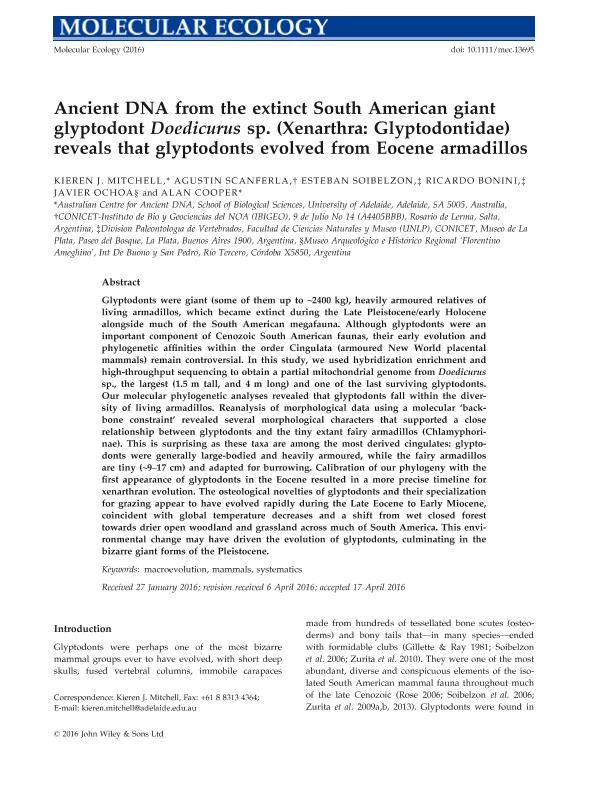Mostrar el registro sencillo del ítem
dc.contributor.author
Mitchell, Kieren J.

dc.contributor.author
Scanferla, Carlos Agustín

dc.contributor.author
Soibelzon, Esteban

dc.contributor.author
Bonini, Ricardo Adolfo

dc.contributor.author
Ochoa, Javier

dc.contributor.author
Cooper, Alan
dc.date.available
2018-06-13T15:40:52Z
dc.date.issued
2016-05-09
dc.identifier.citation
Mitchell, Kieren J.; Scanferla, Carlos Agustín; Soibelzon, Esteban; Bonini, Ricardo Adolfo; Ochoa, Javier; et al.; Ancient DNA from the extinct South American giant glyptodont Doedicurus sp. (Xenarthra: Glyptodontidae) reveals that glyptodonts evolved from Eocene armadillos; Wiley Blackwell Publishing, Inc; Molecular Ecology; 25; 14; 9-5-2016; 3499-3508
dc.identifier.issn
0962-1083
dc.identifier.uri
http://hdl.handle.net/11336/48521
dc.description.abstract
Glyptodonts were giant (some of them up to ~2400 kg), heavily armoured relatives of living armadillos, which became extinct during the Late Pleistocene/early Holocene alongside much of the South American megafauna. Although glyptodonts were an important component of Cenozoic South American faunas, their early evolution and phylogenetic affinities within the order Cingulata (armoured New World placental mammals) remain controversial. In this study, we used hybridization enrichment and high‐throughput sequencing to obtain a partial mitochondrial genome from Doedicurus sp., the largest (1.5 m tall, and 4 m long) and one of the last surviving glyptodonts. Our molecular phylogenetic analyses revealed that glyptodonts fall within the diversity of living armadillos. Reanalysis of morphological data using a molecular ‘backbone constraint’ revealed several morphological characters that supported a close relationship between glyptodonts and the tiny extant fairy armadillos (Chlamyphorinae). This is surprising as these taxa are among the most derived cingulates: glyptodonts were generally large‐bodied and heavily armoured, while the fairy armadillos are tiny (~9–17 cm) and adapted for burrowing. Calibration of our phylogeny with the first appearance of glyptodonts in the Eocene resulted in a more precise timeline for xenarthran evolution. The osteological novelties of glyptodonts and their specialization for grazing appear to have evolved rapidly during the Late Eocene to Early Miocene, coincident with global temperature decreases and a shift from wet closed forest towards drier open woodland and grassland across much of South America. This environmental change may have driven the evolution of glyptodonts, culminating in the bizarre giant forms of the Pleistocene.
dc.format
application/pdf
dc.language.iso
eng
dc.publisher
Wiley Blackwell Publishing, Inc

dc.rights
info:eu-repo/semantics/openAccess
dc.rights.uri
https://creativecommons.org/licenses/by-nc-sa/2.5/ar/
dc.subject
Evolution
dc.subject
Macroevolution
dc.subject
Mammals
dc.subject
Systematics
dc.subject.classification
Meteorología y Ciencias Atmosféricas

dc.subject.classification
Ciencias de la Tierra y relacionadas con el Medio Ambiente

dc.subject.classification
CIENCIAS NATURALES Y EXACTAS

dc.title
Ancient DNA from the extinct South American giant glyptodont Doedicurus sp. (Xenarthra: Glyptodontidae) reveals that glyptodonts evolved from Eocene armadillos
dc.type
info:eu-repo/semantics/article
dc.type
info:ar-repo/semantics/artículo
dc.type
info:eu-repo/semantics/publishedVersion
dc.date.updated
2018-04-24T15:14:08Z
dc.journal.volume
25
dc.journal.number
14
dc.journal.pagination
3499-3508
dc.journal.pais
Reino Unido

dc.journal.ciudad
Londres
dc.description.fil
Fil: Mitchell, Kieren J.. University of Adelaide; Australia
dc.description.fil
Fil: Scanferla, Carlos Agustín. Consejo Nacional de Investigaciones Científicas y Técnicas. Centro Científico Tecnológico Conicet - Salta. Instituto de Bio y Geociencias del NOA. Universidad Nacional de Salta. Facultad de Ciencias Naturales. Museo de Ciencias Naturales. Instituto de Bio y Geociencias del NOA; Argentina
dc.description.fil
Fil: Soibelzon, Esteban. Universidad Nacional de La Plata. Facultad de Ciencias Naturales y Museo. División Paleontología Vertebrados; Argentina. Consejo Nacional de Investigaciones Científicas y Técnicas; Argentina
dc.description.fil
Fil: Bonini, Ricardo Adolfo. Universidad Nacional de La Plata. Facultad de Ciencias Naturales y Museo; Argentina. Consejo Nacional de Investigaciones Científicas y Técnicas; Argentina
dc.description.fil
Fil: Ochoa, Javier. Consejo Nacional de Investigaciones Científicas y Técnicas; Argentina. Provincia de Córdoba. Museo Arqueológico e Histórico Regional ‘Florentino Ameghino’; Argentina
dc.description.fil
Fil: Cooper, Alan. University of Adelaide; Australia
dc.journal.title
Molecular Ecology

dc.relation.alternativeid
info:eu-repo/semantics/altIdentifier/url/https://onlinelibrary.wiley.com/doi/abs/10.1111/mec.13695
dc.relation.alternativeid
info:eu-repo/semantics/altIdentifier/doi/https://dx.doi.org/10.1111/mec.13695
Archivos asociados
